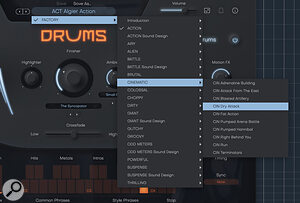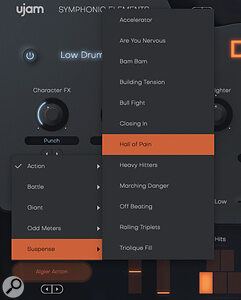Hans Zimmer’s drum collection doesn’t disappoint.
UJAM made quite a splash with Striiiings, the first release in their Symphonic Elements series, bringing their user‑friendly ‘virtual performer’ instrument format to the orchestral string section (see the review in SOS April 2021 issue). They have now added a second title to that series — Drums — and while the name only contains one vowel in the middle rather than four, in a neat bit of graphic design, the central ‘u’ is rather nicely stylised in the shape of a timpani.
As with Striiiings, Drums is a collaboration with UJAM co‑founder Hans Zimmer, featuring heavyweight drum samples from the Hollywood superhero’s own collection and presented within a similar phrase/pattern‑based format. So, if you are looking to get a dose of Zimmeresque drums into your own productions, is Drums going to hit the spot?
Engine Efficiency
The Drums UI will be instantly familiar to Striiiings users, with the Low Strings and High Strings sections replaced by Low Drums (bass drums and timpani) and High Drums (toms and snares) respectively. While the user cannot pick and load individual drum sounds into the UI, amongst the 300 global presets there is an impressive range of underlying drum sounds; if you need ‘naked’ orchestral drums, Drums can certainly do that. Each preset also includes five individually playable samples (two ‘Hits’ and three ‘Metals’ including some cymbals) that you can use to add your own touches to the 23 rhythmic phrases included within each global preset.
 The huge selection of global presets spans a broad range of musical styles, and both conventional and sound‑designed drums.Those global presets also make use of the very flexible sound‑design elements that dominate the upper half of the UI and therefore provide flavours that span more conventional orchestral percussion (where the quality of the underlying drum samples is clearly heard), through to the super‑hyped (where the potential of the sound‑design options is clearly demonstrated). Embedded within each of these global presets is one of the 50+ playing style presets. You can select these independently in the lower left of the UI so, if you like the sounds from one global preset, and the patterns from a different style, you can mix and match as required.
The huge selection of global presets spans a broad range of musical styles, and both conventional and sound‑designed drums.Those global presets also make use of the very flexible sound‑design elements that dominate the upper half of the UI and therefore provide flavours that span more conventional orchestral percussion (where the quality of the underlying drum samples is clearly heard), through to the super‑hyped (where the potential of the sound‑design options is clearly demonstrated). Embedded within each of these global presets is one of the 50+ playing style presets. You can select these independently in the lower left of the UI so, if you like the sounds from one global preset, and the patterns from a different style, you can mix and match as required.
As with Striiiings, the patterns and/or hits can be triggered via MIDI notes (or using the graphic keyboard at the bottom of the UI). In any Style, as well as the aforementioned individual hits, the patterns range in intensity, and include intro, endings and fills. The Low Drums and High Drums sections can be individually muted and you can crossfade the balance between them using the on‑screen fader or the pitch‑bend wheel. The mod wheel can be used to vary the playing dynamics. For the user, the combination of controls used to create a performance is therefore very simple, but it provides all you need to build a full performance with lots of variety and in double‑quick time.
Designer Drums
The global presets are well organised. Some categories (for example, the Action, Battle or Giant categories) are dominated by presets where the only real processing applied to the drums is some suitable ambience. However, elsewhere the presets make more extensive use of Drum’s sound‑design features. In that regard, both the Low Drums and High Drums sections have their own set of Character FX, Motion FX, Focus EQ and Shape controls.
 Over 50 style‑based sets of preset patterns provide plenty of performance variety.Both the Character and Motion FX are, themselves, macro‑based; you pick an effect preset for each and can then dial in as much or as little of that effect as you want. There are some very cool options available within the two effect types, with Character including various EQ, dynamics, distortion and bit‑depth options, while Motion includes a range of filter, gate, glitch and delay choices. The Focus EQ provides a one‑knob macro‑EQ control, while the Shape slider allows you to adjust the amplitude envelope of the drums to emphasise the attack or decay as required.
Over 50 style‑based sets of preset patterns provide plenty of performance variety.Both the Character and Motion FX are, themselves, macro‑based; you pick an effect preset for each and can then dial in as much or as little of that effect as you want. There are some very cool options available within the two effect types, with Character including various EQ, dynamics, distortion and bit‑depth options, while Motion includes a range of filter, gate, glitch and delay choices. The Focus EQ provides a one‑knob macro‑EQ control, while the Shape slider allows you to adjust the amplitude envelope of the drums to emphasise the attack or decay as required.
As well as the Crossfade slider, the central portion of the UI includes the global Highlighter, Ambience and Finisher effects. Highlighter provides a 24dB synthesizer‑style filter combining a low‑pass and resonant high‑pass filter. Like all of Drums’ controls, it can be automated so, if you want to add some global filter sweeps to emphasis a build or transition, Highlighter makes that a simple task. The Ambience options provide a range of treatments, with a good selection of conventional space sizes and styles and also some more creative delay‑based options that can turn a simple pattern into something more complex.
This is all topped off with the macro‑based Finisher effect. Under the hood, each Finisher preset is a multi‑effects chain and, while some of these are more conventional in nature (for example, offering EQ and compression), there are plenty of more creative choices as well. These include some cool delay and modulation options, various distortion/saturation treatments, glitch and pitch possibilities and some impressive filter processing. Some of these can take your conventional drum sounds right out into the realms of other‑worldliness and would be ideal for a more modern ‘hybrid scoring’ approach or for contemporary pop and electronica production. The excellent PDF manual provides a useful list of the Finisher presets.
Drums Does Deadlines
UJAM’s design ethic is always one that emphasises a streamlined workflow. As ever, the underlying sounds are high quality, but the macro‑based control set is carefully curated to ensure adequate sonic options without compromising ease (and speed) of use. If you need an epic, cinematic‑style drum track in an instant (whether that’s to hit a deadline or to avoid a creative mood getting lost in parameter paralysis), Drums ticks lots of boxes.
Indeed, provided you are willing to suspend your inner control‑freak who wants to select each individual drum sound and play in all your rhythms by hand (and, if you are not, Drums is perhaps not the product for you), then Drums is an absolute blast. When building a performance from one of the more conventional global presets, sonically, Drums does not disappoint, however, it is capable of much more than that and I think many contemporary TV/film composers are going to find plenty that appeals here. The sound‑design options let you easily go from super‑hyped and epic down to (with suitable use of the various filter options) super‑small tickers and pulses.
For those that welcome how UJAM’s design choices trade off conventional drum selection/playing manually for a super‑slick workflow and hugely creative sound design, then Drums is a very attractive proposition.
Yes, you do have to work within the supplied preset patterns, but these span both the simple and the complex and, in practice, with over 1200 patterns in total, there is plenty of mileage to be had. That’s not to say that MIDI export (as found is some of UJAM’s other virtual performance instruments) would not be welcome, but I suspect that is perhaps a more difficult technical challenge with the Striiiings and Drums engine. If I was feeling particularly greedy, the other obvious extra I’d love to see is an A/B switch that allows you to toggle between two different states of the effects processing components of the engine. Without threatening the streamlined ethos of the UI design, this could allow you to easily switch between a clean and a processed state, or two different styles of processing, making a single instance even more flexible.
So, who might buy Drums? Well, while it is not perhaps in the casual purchase bracket, neither does entry require a Hollywood budget. Indeed, given just what’s on offer, like Striiiings, I think Drums is very competitively priced. If you are seeking a conventional orchestral drum library and want to play your own parts, perhaps Drums is not the obvious choice. However, for those that welcome how UJAM’s design choices trade off conventional drum selection/playing manually for a super‑slick workflow and hugely creative sound design, then Drums is a very attractive proposition. And, icing on the sonic cake, it is tremendous fun to use; top‑notch stuff from UJAM, and the 30‑day free trial is well worth a download.
Summary
Drums makes the creation of epic cinematic‑style drum tracks, whether conventional or sound‑designed, frighteningly easy. The design choices might not suit everyone, but the results are very impressive.

